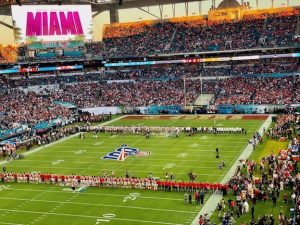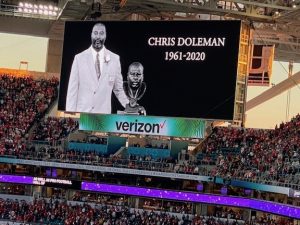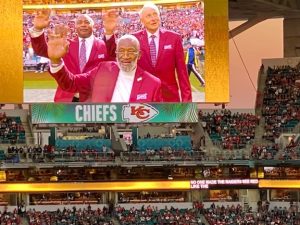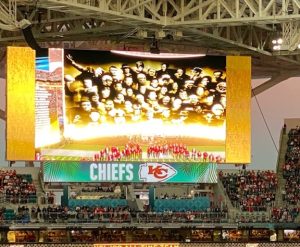Bay Area
Mahomes, Chiefs rally late to win Super Bowl LIV

Miami – Three late touchdowns in the fourth quarter by the Kansas City Chiefs stunned the Forty-Niners in what was the best comeback victory in Super Bowl history. The 49ers defense smothered the Chiefs offense in the third quarter, shut down in the fourth San Francisco appeared to have celebrated too soon.
Crucial mistakes this time proved costly as the 49ers suffered a tough 31-20 loss to Kansas City who are now the Super Bowl Champs for the first time in 50 years. Patrick Mahomes was named the MVP after leading his team to victory.
“I just tried to fight, and obviously the third quarter didn’t go the way I wanted it to,” said Maohmes. “I tried to force some things and had some turnovers. I mean, that’s a really good defense, and so I didn’t play to my liking in that third quarter, but guys believed in me and gave me confidence. We kept fighting and we found ways to win it in the end.”
San Francisco had a good lead to start the second half. But the Chiefs are known for their epic comebacks late in the game. With 6:30 left on the clock, a pass interference called on Tarvarius Moore came after Mahomes went deep to Travis Kelce on a 43 yards pass.
That setup Kelce’s 1-yard touchdown making it a 20-17 game. Unable to score on the next drive, Kansas City scored their second touchdown, Mahomes connected with Damien Williams for a 5-yard touchdown, that play gave the Chiefs their first lead of the night. At the two-minute warning the 49ers had a chance to turn things around, but three incomplete passes followed with a sack on Jimmy Garoppolo on 4th down.
Kansas City got the ball back, Williams rushed for 4 yards before Kyle Shanahan took a timeout. Williams then rushed for a 38-yard touchdown to secure the Chiefs win. San Francisco’s offense and defense collapsed in the fourth quarter leaving the team dejected as Kansas City began to celebrate.
“I think the turning point was when we got a turnover and then we didn’t execute on offense and they got the ball right back and drove 87 yards or however how far it was,” TE George Kittle said. “As an offense, we have to end the game right there, and we didn’t.”
Garoppolo threw his second interception to end the game. The 49ers registered two interceptions on the night, with Fred Warner and Moore each but against a dominant Chiefs defense it just wasn’t enough. San Francisco finished the 2019 postseason with 5 interceptions, which is tied for the 4th most in a single postseason in franchise history.
The 49ers seemed to have everything under control until the six-minute mark in the fourth quarter. Both teams scored and kicked a field goal to end the half tied at 10-10. After Samuel rushed for 32 yards, Robbie Gould kicked a 38-yard field goal for a quick 3-0 lead.
Mahomes scrambled for 2 yards in the red zone, then rushed in for a 1-yard touchdown making it a 7-3 game. By the second, Garoppolo’s pass intended for Samuel was intercepted by Bashaud Breeland. That setup Harrison Butker’s 31-yard field goal to extend the Chiefs lead to 10-3.
Garoppolo then connected with Samuel for 16 yards before San Francisco went to the running game, Raheem Mostert rushed for 11 yards and Tevin Coleman rushed for 17 yards. Garoppolo found a wide-open Kyle Juszczyk who rushed into the end zone for 15-yard touchdown to tie the game 10-10.
To start the third Gould kicked a 42-yard field goal giving the 49ers a 13-10 lead. After Mahomes pass was blocked by Nick Bosa, who almost forced a fumble, Mahomes went deep to Tyreek Hill but his pass was intercepted by Warner. That setup Mostert’s 1-yard touchdown extending their lead 20-10. San Francisco did not score again after that play.
“It definitely hurts, FB Juszczyk said. “At the end of the day, that’s exactly the position we wanted to be in. So, I think that makes it hurt a little bit more, but you couldn’t have asked to be in a better situation.”
Before the game, there was an emotional tribute to Kobe Bryant and those who lost their lives in the helicopter crash last Sunday. Both NFL teams lined up on the 24 yard line to honor all nine victims killed in that crash that included NBA great Kobe Bryant and his daughter Gianna Bryant. The NFL also honored their own, Hall of Famer Chris Dolan who lost his battle with Cancer.


Photos by Malaika Bobino

The NFL then honored 100 years in football with the greatest quarterbacks to ever play the game along with defense, offense, coaches, dynasty teams and those who you might not remember but made an impact as well.



Activism
Oakland Post: Week of May 28 – June 30, 2025
The printed Weekly Edition of the Oakland Post: Week of May 28 – June 3, 2025

To enlarge your view of this issue, use the slider, magnifying glass icon or full page icon in the lower right corner of the browser window.
Activism
Oakland Post: Week of May 21 – 27, 2025
The printed Weekly Edition of the Oakland Post: Week of May 21 – 27, 2025

To enlarge your view of this issue, use the slider, magnifying glass icon or full page icon in the lower right corner of the browser window.
Bay Area
Chevron Richmond Installs Baker Hughes Flare.IQ, Real-time Flare Monitoring, Control and Reduction System
While the sight of flaring can cause concern in the community, flares are essential safety systems that burn pollutants to prevent them from being released directly into the atmosphere. They activate during startup and shut-down of facility units or during upsets or equipment malfunctions. The typical flare stack is about 200 feet high so that vapors are well above street levels.

The Richmond Standard
Chevron Richmond recently installed flare.IQ, a real-time, automated system that will improve the facility’s flaring performance.
The technology, developed by Panametrics, a Baker Hughes business, uses sensors to monitor, reduce and control flaring in real time. It collects and assesses data on refinery processes, such as temperature, pressure, gas flow and gas composition, and adjusts accordingly to ensure flares burn more efficiently and cleanly, leading to fewer emissions.
“The cleaner the flare, the brighter the flame can look,” said Duy Nguyen, a Chevron Richmond flaring specialist. “If you see a brighter flame than usual on a flare, that actually means flare.IQ is operating as intended.”
While the sight of flaring can cause concern in the community, flares are essential safety systems that burn pollutants to prevent them from being released directly into the atmosphere. They activate during startup and shut-down of facility units or during upsets or equipment malfunctions. The typical flare stack is about 200 feet high so that vapors are well above street levels.
“A key element in Baker Hughes’ emissions abatement portfolio, flare.IQ has a proven track record in optimizing flare operations and significantly reducing emissions,” said Colin Hehir, vice president of Panametrics, a Baker Hughes business. “By partnering with Chevron Richmond, one of the first operators in North America to adopt flare.IQ, we are looking forward to enhancing the plant’s flaring operations.”
The installation of flare.IQ is part of a broader and ongoing effort by Chevron Richmond to improve flare performance, particularly in response to increased events after the new, more efficient hydrogen plant was brought online in 2019.
Since then, the company has invested $25 million — and counting — into flare minimization. As part of the effort, a multidisciplinary refinery team was formed to find and implement ways to improve operational reliability and ultimately reduce flaring. Operators and other employees involved in management of flares and flare gas recovery systems undergo new training.
“It is important to me that the community knows we are working hard to lower emissions and improve our flaring performance,” Nguyen said.
Also evolving is the process by which community members are notified of flaring incidents. The Community Warning System (CWS), operated by Contra Costa County is an “all-hazard” public warning system.
Residents can opt-in to receive alerts via text, e-mail and landline. The CWS was recently expanded to enable residents to receive notifications for “Level 1” incidents, which are considered informational as they do not require any community action.
For more information related to these topics, check out the resources included on the Chevron Richmond, CAER and Contra Costa Health websites. Residents are also encouraged to follow @chevronrichmond and @RFDCAOnline on Facebook and X (formerly Twitter), where additional information may be posted during an incident.
-

 Activism3 weeks ago
Activism3 weeks agoAfter Two Decades, Oakland Unified Will Finally Regain Local Control
-

 Activism3 weeks ago
Activism3 weeks agoOakland Post: Week of May 14 – 20, 2025
-

 Activism3 weeks ago
Activism3 weeks agoNew Oakland Moving Forward
-

 Alameda County3 weeks ago
Alameda County3 weeks agoOakland Begins Month-Long Closure on Largest Homeless Encampment
-

 Barbara Lee3 weeks ago
Barbara Lee3 weeks agoWNBA’s Golden State Valkyries Kick Off Season with Community Programs in Oakland
-

 Activism3 weeks ago
Activism3 weeks agoEast Bay Community Foundation’s New Grants Give Oakland’s Small Businesses a Boost
-

 Bo Tefu3 weeks ago
Bo Tefu3 weeks agoGov. Newsom Highlights Record-Breaking Tourism Revenue, Warns of Economic Threats from Federal Policies
-

 Bay Area3 weeks ago
Bay Area3 weeks agoChevron Richmond Installs Baker Hughes Flare.IQ, Real-time Flare Monitoring, Control and Reduction System




















































